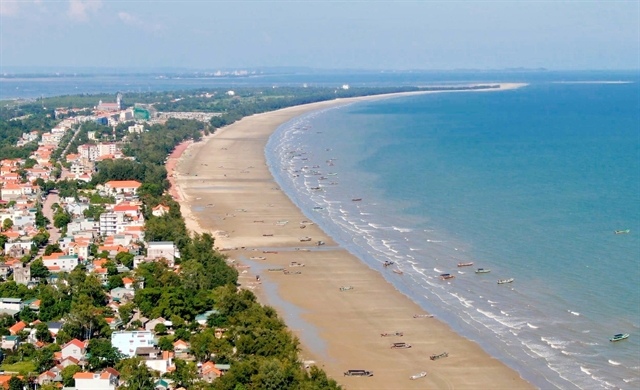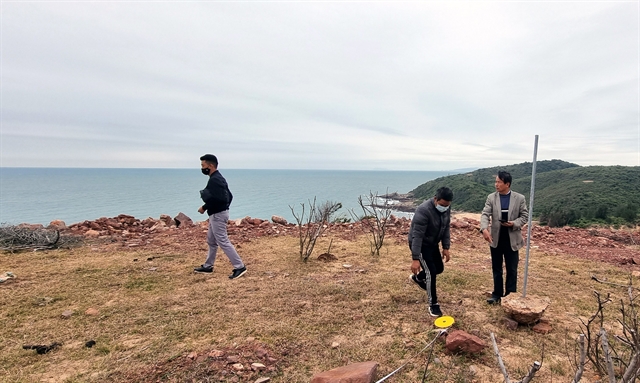 Economy
Economy

 |
| As a coastal city, Móng Cái has a rich potential for developing renewable energy sources. — VNA/VNS Photos Văn Đức |
HÀ NỘI — The northern province of Quảng Ninh has been calling for domestic and foreign investment in renewable and clean energy to mitigate climate change, protect the environment and ensure sustainable socio-economic development.
With its geographic advantage (being on the coast), the province has paid attention to preserving and promoting the sustainable values of the natural environment and synchronously perfecting the infrastructure system in recent years. In particular, it has prioritised facilitating the development of renewable energy.
According to Cao Tường Huy, permanent deputy chairman of Quảng Ninh People's Committee, the province was currently the nation's power production centre with a diversified power transmission system. Additionally, it could produce about 13GW of offshore wind power. These are comparative advantages to attract investment in developing clean and renewable energy.
A survey from the Institute of Energy under the Ministry of Industry and Trade (MoIT) showed that Quảng Ninh has excellent potential for wind power development (onshore and offshore), about 13,000MW along the coast and about 2,300MW onshore. This energy source is most concentrated in Cô Tô District and Móng Cái City.
Thanks to the potential mentioned above, Móng Cái City itself planned to develop renewable energy on Vĩnh Thực and Vĩnh Trung islands soon.
 |
| Officials survey and evaluate the wind power potential of Vĩnh Thực Island. |
Chairman of the Móng Cái City People's Committee Hồ Quang Huy said Móng Cái was gradually carrying out the announced strategies and plans to modernise infrastructure, especially in coastal areas.
Among those strategies and plans, the city would focus on fostering the development of renewable energy to switch from traditional energy sources such as coal, oil, and natural gas to green and safer ones like wind, solar, hydrological, and biological energy in line with the common orientations set up by central and provincial agencies.
According to adjusted planning for the Móng Cái Border Gate Economic Zone approved by the Prime Minister, the zone had a total area of about 121,197ha, including 66,197ha on land and 55,000ha on water that includes such islands as Vĩnh Trung and Vĩnh Thực of Móng Cái City and Cái Chiên of Hải Hà District.
Huy said municipal authorities were revising the planning of Division D1 in the vicinity of Vĩnh Trung and Vĩnh Thực islands to suit the clean and renewable energy development directions issued by the Quảng Ninh administration and central agencies.
After the planning was finalised, the official said that Móng Cái City would seek capable and experienced investors to develop a wind power system.
He added that the development of clean and renewable energy would help the local economy sustainably develop, preserve natural values, and contribute to realising related policies and resolutions of the State and the province.
He added that his city would maximise maritime potential while enhancing the monitoring and protection of the marine environment to help sustainably develop sea-based economic activities.
The Quảng Ninh People's Committee issued a document on studying the potential of offshore and land-based wind power in the province in March.
It assigned the provincial Department of Industry and Trade to team up with some units to survey areas for wind power development, including Vĩnh Trung and Vĩnh Thực islands. This move aimed to help Móng Cái realise its potential and advantages in renewable energy development.
Meanwhile, in a draft planning of Quảng Ninh by 2030 submitted to the Prime Minister, the province identified several focuses, including developing an environmentally friendly energy industry, maintaining its role as an energy centre of Việt Nam and a wind and LNG-fired power centre in the northern region, gradually switching to clean and renewable energy, and developing land-based, inshore and offshore wind power with a total initial capacity of about 2,500MW.
To develop green energy sources, Quảng Ninh also proposed the MoIT to add more megawatts of electricity to the draft of the ten-year (2021-30) Power Development Plan 8 for Việt Nam's energy sector.
The locality suggested that an additional 5,000MW of wind power, including 3,000MW of offshore wind power and 2,000MW of onshore wind power, would be added to the national power plan in 2021-40.
On February 11, 2020, the Politburo issued Resolution No. 55-NQ/TW on orientations for the national energy development strategy by 2030, with a vision to 2045, which gives priority to the capitalisation of renewable, new, and clean energy sources. On October 2, the Government released Resolution No. 140/NQ-CP on an action plan for implementing Politburo's Resolution. — VNS




